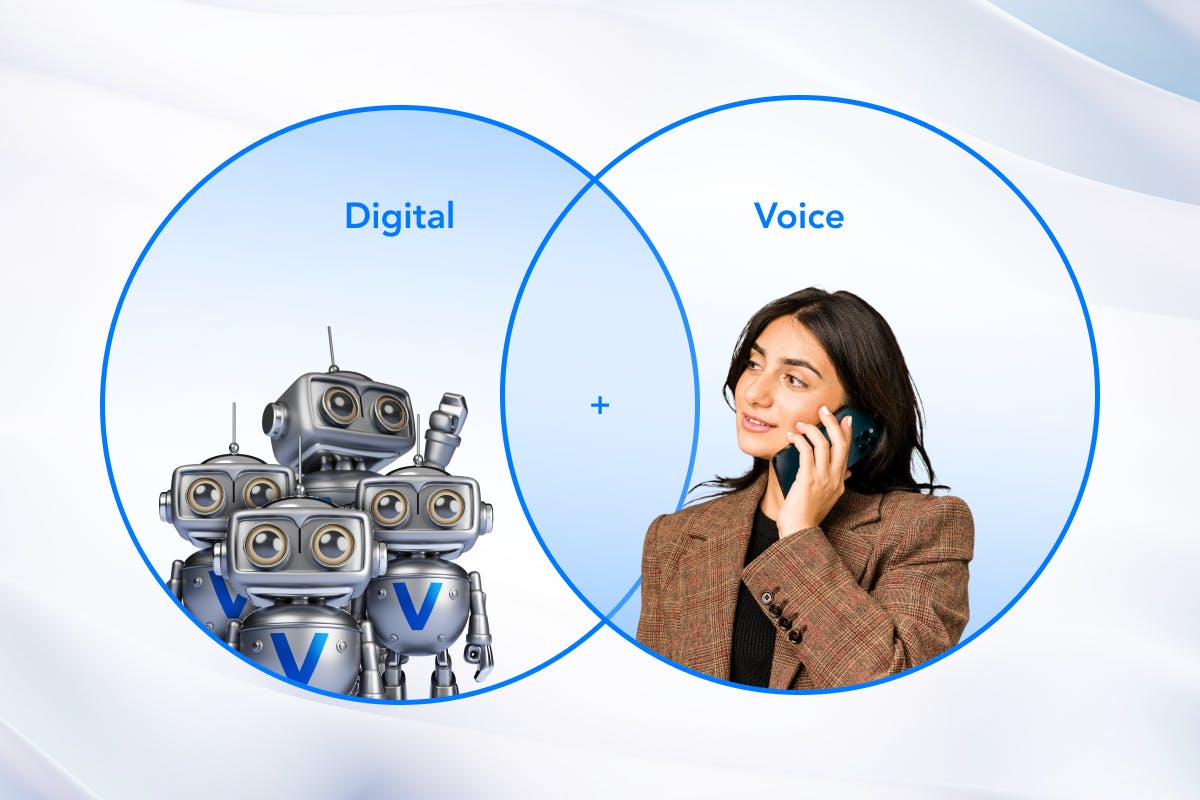Keeping it Contained: How IVA Chatbots for Customer Service Power Great CX


Artificial intelligence (AI) is changing the customer engagement landscape. As consumer expectations grow and budgets shrink, companies can’t hire their way to great CX. So, AI presents significant opportunities for companies to excel at customer engagement while delivering ROI.
Organizations are using AI in several impactful ways—from generating emails and social media posts to writing software code—and one area with proven business value is chatbots (as long as they’re well-designed).
Done right, this technology can quickly answer customer queries, automate tasks and, ultimately, ease the burden on customer service agents.
What Are Customer Service Chatbots?
AI customer service chatbots, also known as IVAs (intelligent virtual assistants) or intelligent virtual agents, are conversational engagement tools. They deliver personalized self-service experiences, effectively resolve customer queries, reduce inbound calls, and ease agent workload. “Intelligent” is the word that sets today’s chatbots apart from the digital tools that consumers had to endure in the recent past.
With an industry-leading chatbot for customer support, consumers can carry on a human-like conversation. An IVA can provide information, take actions on the customer’s behalf, perform transactions—and these uses cross customer service, sales, and marketing functions.
What Does a Customer Service Chatbot Do?
It provides value to customers by anticipating customer needs and provides actionable assistance, meaning that people can resolve their issues within a bot conversation without any escalation to a human agent. For example, rather than asking about how to buy a train ticket, consumers can purchase one during a bot interaction.
Data accessed through API connections also enables chatbots to offer personalized customer experiences and answer customer inquiries differently for each customer (‘When is my auto loan due?’ or ‘Are calls to Mauritius included in my plan?’).
IVAs can also act as a triage and routing tool for brands.
Even if you have a sophisticated chatbot, there are still issues that are best handled by a human agent. In these cases, the bot can send the customer to the best available agent to help resolve the customer’s issue. This reduces escalations due to misrouting—thereby avoiding customer frustration—and reduces costs for the brand.
Verint’s Digital and Voice Containment Bots
Using next-generation conversational AI, Verint’s Voice and Digital Containment bots allow the Verint Intelligent Virtual Assistant to precisely understand a customer’s intent and generate relevant responses across both voice and digital channels.
As powerful customer support tools, they use AI and automation to successfully resolve customer service inquiries with personalized self-service experiences.
What Is the Value of Verint’s Containment Bots?
- Improve CX: Deliver swift, precise and personalized responses without customers being forced to repeat themselves
- Reduce Operational Costs: Customer self-service creates an increase in containment rates, resulting in fewer agent interactions, both voice and digital, which reduces contact center costs
- Deliver 24/7 Support: Customers get real-time support on the digital and voice channel of their choice around the clock, and the bot can collect context in case escalation is needed
- Boost Customer Engagement: With access to the right data, the bots continually improve intent understanding to drive intelligent conversations and increase task completion, return visits and customer retention
- Increase Efficiency: Bots handle repetitive customer queries and customer requests, which lowers waiting times and frees up agents to focus on higher-value work
- Easy to Scale Support: Continuous training on rich behavioral data results in better containment and consistent experiences, easily scaled to meet peak demand and new use cases.
Steps to Take When Building a Virtual Assistant for Customer Engagement
1. Understand the goal: The aim of an AI-powered chatbot or virtual assistant should be to effectively resolve customer inquiries, while also reducing inbound conversations and live agent workload. Analyzing the most common customer intents is the best place to start. This will help brands understand where introducing automation will have the biggest impact.
2. Train the bot: Your IVA is only as good as the data it’s trained on. The most useful behavioral data comes from customer and agent interactions collected from across every engagement channel, as well as surveys or other feedback mechanisms.
Verint Intent Discovery Bot uses advanced artificial intelligence, natural language processing, machine learning to process customer data from multi channels to truly understand what the customer is asking, and in turn helps the IVA provide better responses in the future based on these past interactions. This leads to an improved customer experience through a combination of human and virtual agents.
3. Analyze and optimize: Build a systematized method of gathering feedback and measuring performance to ensure your bot is continually improving to provide customer service. To constantly optimize the IVA, it’s vital to know how accurately it can recognize customer intent, as well as whether the advice or direction provided is also successful.
At Verint, we use visualized conversational analytic reports to demonstrate how the IVA is performing and where improvement can be found.
What Are the Risks to Consider When Deploying an IVA?
No technology comes without risks, but companies can mitigate against them by deploying IVAs with proper planning. Some of the potential risks include:
- Sign-off across the organization
- Risk and compliance teams will likely need input on regulatory issues
- Marketing needs to approve the language to ensure it’s on-brand
- The IT department will want to check the integration with the back-end systems to make sure there are no impacts on other business functions.
- Handling of customer data
- Clear-cut policies on engagement data storage are vital to ensure customer trust in the bot and your brand as you continue leveraging natural language processing
- Companies need to be upfront on where the data is stored, for how long, and how it will be used once collected during an interaction
- Control must be established for who can access the data, especially consumers’ private personal information.
One unheralded risk: creating a mismatch between experiential expectations and the IVA’s actual delivered experience. Or, in more plain English, if you are promising customers a conversation but provide an FAQ that reads like an FAQ, you’ll end up limiting the long-term appeal for customers of the IVA.
How to Choose an IVA Partner
Because there are several hundred bot providers in the marketplace, you need to be wise when choosing a partner to work with. Many, maybe even most, chatbot providers are technology firms with experience in areas such as linguistics and machine learning.
They do not, however, have deep experience in customer service or marketing or sales. Find a partner that has the function you want to automate deep in their DNA.
However, this expertise is only helpful if it exists in a bot-building environment which offers an easy and efficient deployment. An IVA that takes too long to launch means mounting costs and decreased ROI.
Verint’s IVA Studio has a low-code bot-building and bot-management environment, so it’s straightforward to adjust and evolve the bot’s capabilities.
Two Containment Bot Success Stories
Amtrak
The Challenge: The U.S. rail company wanted a scalable digital bot to help its 375,000+ daily website visitors to book tickets, access travel information, and make hotel or hire car reservations.
The Solution: Verint built and rolled out the “Ask Julie” containment bot.
The Results:
- 8x return on investment
- 50% year-over-year growth in containment bot usage
- 30% more revenue generated per booking
- More than 5 million questions answered annually.
Meyer Group
The Challenge: With average handling time at 60 days and minimal first contact resolution, the kitchenware brand needed to address the rising demand for customer interactions.
The Solution: Introducing Verint’s containment bot to automate self-service and reduce wait times.
The Results:
- Average first response time reduced from 10 days to 24 minutes
- 50% reduction in cost-per-contact
- Improved CSAT (customer satisfaction) rating from 45 to 90 (out of 100)
- 60% of customer interactions happen via social media and/or messaging channels
Find out more about Verint’s Digital and Voice Containment bots.